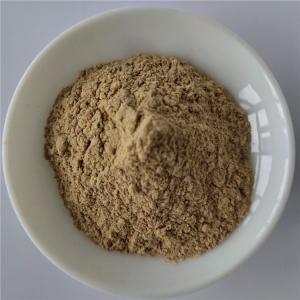
Add to Cart
Insomnia Treatment Slippery Elm Bark Extract With Best Price
Product Details
Product Name: Slippery Elm Bark Extract
Latin Name: ulmus pumila
Used Part: bark
Specifications:4:1
Testing Method: TLC
Appearance: light yellow to brown powder



Product Description
Elm Bark Powder consists of a substance known as mucilage. This includes both campestral and beta-sitosterol in its makeup. This substance has been used for hundreds of years for coughs and sore throats. It has a very powerful ability to soothe all the mucous membranes of the body. The mucilage in the inner bark of the tree has the ability to expand when exposed to liquid as in the throat or breathing passages. This has a very soothing effect on those areas. Elm is a species of elm tree that has been used as an herbal remedy in North America for hundreds of years. It is extremely versatile, providing relief from a number of ailments, including Irritable Bowel Syndrome (IBS) and sore throats. Elm is also known as Ulmus fulma, Red Elm, Sweet Elm, Moose Elm, Indian Elm, Gray Elm, and Soft Elm.
Product Analysis
| Item | Specification | Result | Method |
| BasicProduct Information | |||
| Product name | slippery elm bark extract | ||
| Part of the Plant | bark | Conform | / |
| Country of Origin | China | Conform | / |
| Organoleptic Data | |||
| Appearance | Fine powder | Conform | NLS-QCS-1008 |
| Color | light yellow to brown powder | Conform | GB/T 5492-2008 |
| Odor& Taste | Characteristic | Conform | GB/T 5492-2008 |
| Process Data | |||
| Solvent(s) Used | Water and ethyl alcohol | Conform | / |
| Extract ration | / | Conform | |
| Content | Paeoniflorin≥98% | 98.16 | |
| Drying Method | Spray drying | Conform | / |
| Excipient | Maltodextrin | Conform | / |
| Physical Characteristics | |||
| Particle Size (80 mesh) | 98.0%pass 80mesh | Conform | GB/T 5507-2008 |
| Moisture | <5.0% | 2.7% | GB/T 14769-1993 |
| Ash Content | <4.0% | 1.5% | AOAC 942.05, 18th |
| Solvent Residue | Eur. Pharm | Conform | NLS-QCS-1007 |
| Heavy Metals | |||
| Total Heavy Metals | <10 ppm | Conform | USP <231>, method II |
| Arsenic | <1.0 ppm | Conform | AOAC 986.15, 18th |
| Lead | <1.0 ppm | Conform | AOAC 986.15, 18th |
| Mercury | <0.5 ppm | Conform | AOAC 971.21, 18th |
| Pesticide Residue | |||
| 666 | <0.2ppm | Conform | GB/T5009.19-1996 |
| DDT | <0.2ppm | Conform | GB/T5009.19-1996 |
| Microbiology | |||
| Total Plate Count | <1,000cfu/g | 16cfu/g | AOAC 990.12, 18th |
| Total Yeast & Mold | <100cfu/g | 7cfu/g | FDA (BAM) Chapter 18, 8th Ed. |
| E. Coli | Negative | Negative | AOAC 997.11, 18th |
| Salmonella | Negative | Negative | FDA (BAM) Chapter 5, 8th Ed. |
Elm Bark Powder consists of a substance known as mucilage. This includes both campestral and beta-sitosterol in its makeup. This substance has been used for hundreds of years for coughs and sore throats. It has a very powerful ability to soothe all the mucous membranes of the body. The mucilage in the inner bark of the tree has the ability to expand when exposed to liquid as in the throat or breathing passages. This has a very soothing effect on those areas. Elm is a species of elm tree that has been used as an herbal remedy in North America for hundreds of years. It is extremely versatile, providing relief from a number of ailments, including Irritable Bowel Syndrome (IBS) and sore throats. Elm is also known as Ulmus fulma, Red Elm, Sweet Elm, Moose Elm, Indian Elm, Gray Elm, and Soft Elm.
